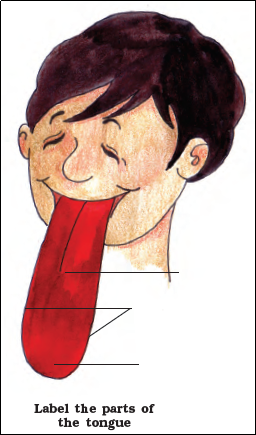NCERT Solutions for Class 5 EVS Chapter 3 - From Tasting To Digesting
FAQs on NCERT Solutions for Class 5 Evs Chapter 3 From Tasting To Digesting
1. What are the correct stepwise NCERT Solutions for Class 5 EVS Chapter 3 ‘From Tasting to Digesting’ as per CBSE 2025–26?
- Taste and chew the food: The process starts when food enters the mouth. Chewing mixes it with saliva.
- Saliva action: Saliva contains enzymes that help break down starch in the food.
- Swallowing: Food passes down the oesophagus to the stomach via peristalsis.
- Stomach digestion: In the stomach, digestive juices and acids break down food further.
- Small intestine absorption: Most digestion and absorption of nutrients occurs here with the help of bile and pancreatic juices.
- Large intestine processing: Water is absorbed from undigested food, forming solid waste for removal.
2. How does the process of tasting and digestion begin, according to NCERT Solutions for Class 5 EVS Chapter 3?
Tasting and digestion start in the mouth. Taste buds on the tongue sense sweet, salty, sour, and bitter flavors. At the same time, chewing and saliva start breaking down the food before swallowing.
3. Why is chewing food properly important for digestion as explained in Class 5 EVS Chapter 3 NCERT Solutions?
- Chewing breaks food into smaller pieces, making it easier to swallow and digest.
- Mixing with saliva starts the digestion of carbohydrates and softens food for smooth movement down the digestive tract.
- Proper chewing helps better absorption of nutrients in the small intestine.
4. What are taste buds, and what role do they play as per NCERT Solutions for Class 5 EVS Chapter 3?
Taste buds are tiny sensory receptors on our tongue that detect tastes such as sweet, salty, sour, bitter, and umami. They send signals to our brain to recognize the flavor of food.
5. Which food items are easy to digest, as mentioned in Class 5 EVS Chapter 3?
Food items that are easy to digest include toasted bread, white rice, bananas, eggs, applesauce, and boiled potatoes. These foods are less likely to cause digestive problems and are recommended when digestion is weak.
6. What is the function of saliva during digestion, according to NCERT Class 5 EVS Chapter 3?
Saliva contains enzymes that start breaking down carbohydrates, softening food for easy swallowing, and helping form a food bolus for safe passage through the oesophagus.
7. What is peristalsis and how does it help digestion, as described in the NCERT Solutions?
Peristalsis is the rhythmic contraction and relaxation of digestive tract muscles, especially in the oesophagus and intestines, which pushes food forward throughout the digestive system.
8. Why is a balanced diet considered important for digestion in Class 5 EVS NCERT Solutions?
A balanced diet supplies all essential nutrients, including proteins, fats, carbohydrates, vitamins, and minerals, which are necessary for the digestive organs to function well and for overall health.
9. What happens if a person does not get enough food or skips meals for a long time, as explained in Chapter 3 of Class 5 EVS?
- Not getting enough food can lead to weakness, stunted growth, lack of energy, and poor immunity.
- Long-term food deprivation can cause malnutrition, hinder mental and physical development, and increase the risk of illnesses.
10. What are some misconceptions about tasting and digestion addressed in the NCERT Solutions for Class 5 EVS Chapter 3?
- Myth: Taste buds only detect four tastes. Fact: There are five tastes—sweet, sour, salty, bitter, and umami.
- Myth: Digestion happens only in the stomach. Fact: Digestion begins in the mouth and continues through the stomach and intestines.
11. How can students use NCERT Solutions for Class 5 EVS Chapter 3 to improve exam scores?
- Practice stepwise solutions as per the CBSE pattern to understand concepts clearly.
- Revise important definitions, diagrams, and activity-based questions.
- Attempt all exercises and sample questions in the NCERT Solutions for more confidence in exams.
12. How is the function of the small intestine different from the stomach in digestion, as per the NCERT Solutions for Class 5 EVS?
The stomach mixes food with digestive juices to break it down into a semi-liquid. The small intestine is where most nutrient absorption takes place, using enzymes and bile to further digest food before absorption into the blood.
13. What are the main organs involved in the digestive process in Class 5 EVS Chapter 3?
The key digestive organs are the mouth, oesophagus, stomach, small intestine, large intestine, liver, and pancreas, each playing a specific role in breaking down and absorbing food.
14. How can improper storage of food grains cause health issues, as discussed in NCERT Solutions for Class 5 EVS Chapter 3?
Improper storage leads to spoilage due to moisture, pests, and contamination, which can cause food-borne illnesses and nutrient loss, emphasizing the importance of safe food storage practices in maintaining health.
15. What higher-order thinking skills (HOTS) questions can arise from ‘From Tasting to Digesting’ in Class 5 NCERT Solutions?
- Analyze: How does chewing food for a longer time affect the digestion process?
- Apply: What might happen if the small intestine is not working properly?
- Evaluate: Why is it important for every child to receive proper nutrition and balanced meals?





















